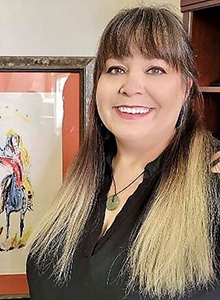Dakota Access Pipeline

Digital divide Indian Country
By Christian HustadBuffalo’s Fire Correspondent
U.S. President Joe Biden’s approval this month of a new COVID-19 pandemic relief package provides tribal governments fresh funding to shorten the digital divide and better serve tribal citizens. The digital divide is the gulf between those who have ready computer access to reliable internet and those who do not.
Residents of tribal lands are the most underserved people in the United States in terms of that connectivity. The $1.9-trillion federal stimulus measure — to stem the public health crisis and economic downturn caused by spread of the deadly novel coronavirus — sets aside $31 billion for tribal governments to deliver vaccinations and other community services, including the internet.
More than 150 tribes that obtained control of broadband spectrum shares during the Federal Communications Commission’s 2020 complementary licensing period already used some of the money from last year’s Coronavirus Aid, Relief, and Economic Security (CARES) Act toward installing better wireless facilities.
For example, the Flathead Nation, home to the Salish, Kootenai and Pend d’Oreilles tribes, used it to build communication towers and establish a broadband network for tribal citizens.

The network allows police officers to issue tickets electronically, patients to use telehealth services, and students to consult online learning resources. It also supports individuals’ personal well-being by helping family members keep in touch.
However, much work remains for the nation to retain its license by proving service coverage to 50 percent of the population in its license area within two years. Part of the stimulus funds from the March 11 American Rescue Package will finish the work needed to boost connectivity, so the people of the Flathead Nation won’t have to leave home to use public Wi-Fi spots that are patchy at best. Information transfer will be faster, and business can be conducted more efficiently.
The more than 400 tribal governments that did not qualify for their FCC licenses in 2020 could still use the rescue package to make up for lost time, according to Petra Wilson, an independent consultant in the commission’s Rural Tribal Window licensing process.
An Oglala Lakota tribal citizen, Wilson said she became a contract coordinator of outreach to tribes because “having access to reliable connectivity is a necessity, not a luxury anymore.” Wilson told Buffalo’s Fire she believes a lot of tribes weren’t made aware of this once-in-a-lifetime opportunity; those that were must build-out, and those that weren’t ought to take advantage of the new money.
“Some tribes are just too remote and it’s not cost-effective to build infrastructure.”
Petra Wilson, founder, Tribal25
“I don’t believe they (FCC) did all the necessary tribal consultation,” she said. “For those who were granted licenses, the next step is getting resources ready to use them.”
Similarly, the next step for tribes that missed the FCC opportunity, she said, is to use the upcoming stimulus money towards creating their own internet service providers — not only for the benefits of high speed, but also to avoid the high cost that comes from commercial internet service providers.
Internet connections aren’t public utilities, she noted. Instead, internet service providers are usually private entities that operate on a profit motive. For tribal governments to serve members, they’ll need to find ways to work with internet providers as well as the federal government, she added.
Tribal lands can cost private companies a lot to service because of significant obstacles to deploying broadband: rugged terrain, different permitting processes, sovereignty concerns, lack of infrastructure, a predominance of residential over business customers, low income levels, cultural and language barriers, low population density, and distance from urban support networks.
“Some tribes are just too remote, and it’s not cost effective to build the infrastructure,” Wilson told Buffalo’s Fire, “and in some places that are connected, I’ve heard of people paying $600 a month!”
Wilson is a strategist for the non-profit MuralNet and founder of Tribal25, LLC. Both organizations benefitted from charitable support to work with tribal governments in licensing broadband with the commission. She named her business after the FCC’S free offer for tribes to control much of the Educational Broadband Service in the 2.5 gigahertz (GHz) band.
Only 65 Percent of American Indians Have Access to Basic Wireless Services
Both the Federal Communications Commission and the Department of Agriculture’s Rural Utilities Service are charged with overseeing high speed internet access on tribal lands. They recognize that roughly nine out of 10 American adults use the internet while only 65 percent of American Indians have access to basic wireless services, leaving 1.5 million disconnected.
They acknowledge a 17-percent increase in employees working from home during the year-old pandemic. Meanwhile, the Government Accountability Office notes that high-speed internet users’ diverse vicinities result in discrepancies in reporting on who has access.
One thing’s for sure, without reliable connections to the internet, tribal employees working from home during the pandemic and reservation residents suffering unemployment woes even before the pandemic have been increasingly hampered by lack of equitable access because of it.
Christian Hustad is an Assiniboine content creator; you can contact him at cjhustad.94@gmail.com.
© Buffalo's Fire. All rights reserved.
This article is not included in our Story Share & Care selection.The content may only be reproduced with permission from the Indigenous Media Freedom Alliance. Please see our content sharing guidelines.
After some reworking, law enforcement backs newest alert system
"Our people are worth it": NCAI panel confronts epidemic of violence, long road ahead and need for unity
Reporting Excellence
Youth take on coding and circuit boards at United Tribes Technical College
A guide to the best Native American movies and series — from landmark Native-made films to major studio collaborations that got it right







